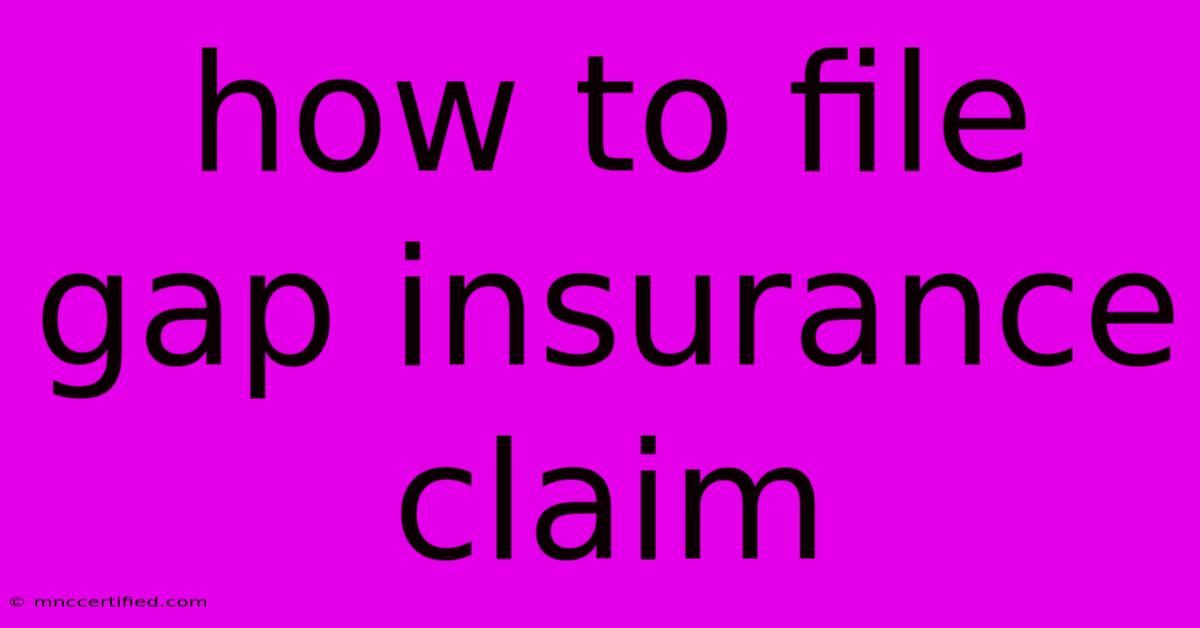How To File Gap Insurance Claim

Table of Contents
How to File a Gap Insurance Claim: A Step-by-Step Guide
Gap insurance can be a lifesaver after a car accident or theft. But knowing how to file a claim can be confusing. This comprehensive guide walks you through the entire process, ensuring a smooth and successful claim experience. We'll cover everything from understanding your policy to receiving your payout.
Understanding Your Gap Insurance Policy
Before filing a claim, thoroughly review your gap insurance policy. This crucial step will save you time and potential frustration later. Key information to locate includes:
- Policy Number: This is your primary identifier. Keep it readily available throughout the claims process.
- Claim Contact Information: Note the phone number and address for reporting claims. Many insurers offer online claim portals as well.
- Covered Situations: Understand precisely what events your gap insurance covers. Most policies cover total loss due to theft or accident, but specifics can vary.
- Deductible (if applicable): Some gap insurance policies have deductibles, similar to other types of insurance. Knowing this upfront avoids surprises.
- Documentation Requirements: Familiarize yourself with the documents needed to support your claim. This often includes the police report, vehicle title, and repair estimate (or salvage value documentation).
Steps to File a Gap Insurance Claim
Filing a claim usually involves these key steps:
1. Report the Incident to the Authorities and Your Main Car Insurer
Immediately after an accident or theft, report the incident to the appropriate authorities (police, etc.). Simultaneously, notify your primary auto insurance company. Obtain a claim number from them and gather all relevant documentation from the accident or theft report. This documentation is vital for your gap insurance claim.
2. Contact Your Gap Insurance Provider
Once you’ve reported to the authorities and your main insurer, contact your gap insurance provider using the contact information from your policy. Clearly explain the situation and provide your policy number. They'll likely guide you through the next steps.
3. Gather Necessary Documentation
This is where having read your policy pays off. You'll typically need:
- Police Report: A crucial document for proving the loss.
- Vehicle Identification Number (VIN): Confirms the identity of the vehicle.
- Proof of Ownership: Usually your vehicle title.
- Insurance Claim Number (from your primary auto insurer): Shows your primary insurer’s assessment of the loss.
- Repair Estimate or Salvage Value: This depends on the situation. If the vehicle is repairable, you'll need an estimate. If it's a total loss, you'll need the salvage value.
- Photographs: Pictures of the damage or the theft scene can be helpful.
4. Submit Your Claim
Most gap insurance providers offer multiple ways to submit your claim: online portals, mail, or phone. Choose the method most convenient for you. Follow the provider's instructions carefully and ensure all required documentation is included.
5. Follow Up
After submitting your claim, follow up with your gap insurance provider to check on its status. This helps ensure your claim is processed promptly. Keep records of all communication with the provider.
Common Reasons for Gap Insurance Claim Denials
Understanding potential reasons for denial can help you avoid issues:
- Incomplete Documentation: Failure to provide all necessary documents is a common reason for delays or denials.
- Policy Exclusions: Your policy might exclude certain events or circumstances. Carefully review the terms and conditions.
- Fraudulent Claims: Attempting to defraud the insurer will result in claim denial.
- Late Reporting: Failing to report the incident within the stipulated timeframe in your policy can lead to a denial.
Tips for a Smooth Gap Insurance Claim Process
- Read your policy carefully: This is the most crucial step.
- Keep detailed records: Maintain copies of all documents and communication.
- Respond promptly to requests: Don't delay responding to requests from the insurer.
- Be honest and accurate: Provide truthful and complete information.
- Seek professional assistance: If you're struggling, consider consulting a lawyer or insurance professional.
By following these steps and understanding the potential pitfalls, you can navigate the gap insurance claim process effectively and receive the compensation you're entitled to. Remember, proactive preparation and clear communication are key to a successful outcome.

Thank you for visiting our website wich cover about How To File Gap Insurance Claim. We hope the information provided has been useful to you. Feel free to contact us if you have any questions or need further assistance. See you next time and dont miss to bookmark.
Featured Posts
-
Dublin Hotel Assault Mc Gregors Jury Trial
Nov 23, 2024
-
Laparoscopy Cost With Insurance
Nov 23, 2024
-
Pennsylvania Senate Race Casey Concedes
Nov 23, 2024
-
Loeffler Trumps Ag Secretary Pick
Nov 23, 2024
-
Leicester City Vs Chelsea Live Score And Goals
Nov 23, 2024